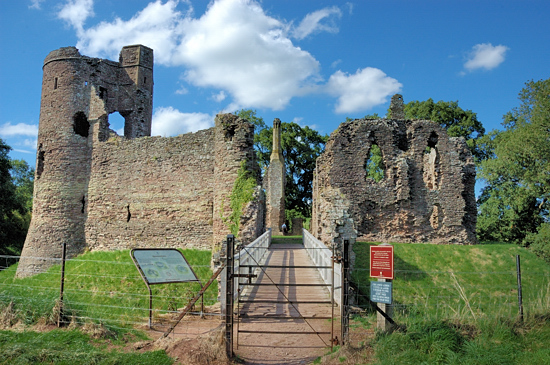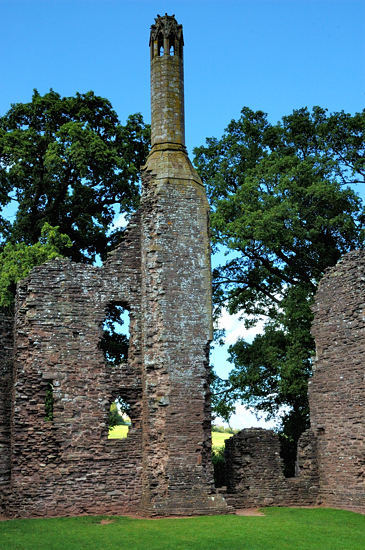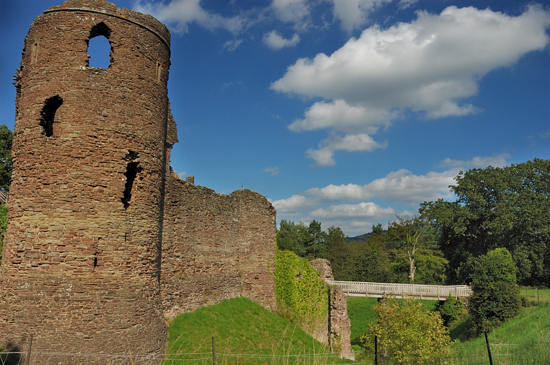Grosmont Castle
Grosmont, Monmouthshire
|

Location Guide
 |
Gosmont Castle is situated behind some houses
in the village of Grosmont. It is site which is open all year round and although
looked after and managed by CADW it is not one of their sites where they have
staff or volunteers or shops or any facilities available. However in the village
there is a pub and a local shop which will have these facilities when they are
open.
 
History
Grosmont Castle would seem to have been founded
after the time of William FitzOsbern, 1st Earl of Hereford. The Earl was killed
the following year and his son Roger de Breteuil, 2nd Earl of Hereford was
stripped of his lands in 1075. The ownership of the land on which castle was
built, is not exactly known but is believed to have either passed to the control
of the de Ballun family of Abergavenny or the de Lacys of Weobley, Ludlow and
Longtown. However it is known that the powerful Marcher Lord Pain Fitz John
acquired Grosmont in the reign of King Henry I of England (1100-35) and
converted it into the head of a lordship which stretched from
White Castle
 in the west to Orcop
castle in the east. in the west to Orcop
castle in the east.
In 1134 rebellion broke out in Wales and in
1137 Pain Fitz John was killed in action fighting against the Welsh. In 1139
Brien FitzCount of Abergavenny took the castle from the King and in 1142 granted
it by charter to Walter of Hereford. Walter was killed around 1160 fighting in
the Holy Land. At this point King Henry II reclaimed the castle and placed royal
soldiers within its walls. The castle, requiring little maintenance, remained a
royal fortress for the next forty years. In 1201 it was granted to Hubert de
Burgh, an officer in the royal service, by King John ‘for his maintenance' in
the wars of the period.
Gosmont today is the substantial remains of the
original 13th century castle still standing and it is one of 3 castles that were
granted to Hubert de Burgh, in 1201. The other two castles were
Skenfrith Castle,
 5 miles south
east and
White Castle, 5 miles south
east and
White Castle,
 6 miles
south. Hubert fortified them in 1204 when he became a prisoner of war in France,
and it was not until 1219 that he regained them. 6 miles
south. Hubert fortified them in 1204 when he became a prisoner of war in France,
and it was not until 1219 that he regained them.
| Royal records from when Hubert was running the
government of England, show that he was undertaking building work at Grosmont
between 1224 and 1226. His buildings included the gatehouse, which has mostly
disappeared in the last 100 years, and the three D-shaped towers in the castle's
enceinte. It remained with Hubert until 1239. In 1267 King Henry III granted the
castle to his second son who then undertook a major conversion. He demolished
one of the D-shaped towers and built accommodation over it and raised the height
and extended the south-west tower to make it into a five-storey tower or keep.
The living quarters of this tower could only be approached via a wooden stairway
to the north. To the east was a giant false doorway which only allowed access to
the ground and first floors. As a part of this reconstruction he also built a
great chimney which can still be seen on a visit today. The steps which go up to
the castle wall walk, is the work of twentieth century restorers who are also
responsible for the creation of much of the double doorway into the early hall. Its most notable and controversial feature is
the large first-floor hall which is believed to have been built 40 years earlier
than some suggest. There are many reasons to believe that the hall was built
early in the castle's history for the evidence points clearly to the castle
having been fortified in stone from the first. Who actually first built the
castle though, is more of a problem. It still stands two stories high and has
many features of comfort within its walls.
It was rebuilt as a residence in the 14th
century and strengthened 100 years later, but by the start of the 17th century
it had fallen into ruins.
 |
 |
Access to Grosmont is along a solid path
from the village road opposite the church and near the local shop, and then a
short walk across a field. You then go through a small narrow gate across a
wooden bridge which goes over the now empty moat. There are information panels
by the entrance and in the internal ward giving a brief history of the ruin.
 
 a gallery is available for this castle, which links back to this page.
a gallery is available for this castle, which links back to this page.
|
Location: Grosmont Castle, Monmouthshire |
|
Grid Reference:
SO405244 |
Ceremonial County:
Monmouthshire |
|
Map Link:
Multimap

|
Aerial photo:
Multimap Aerial View
 |
|
Getting there: From Hereford take the A465
towards Abergavenny at Ewyas Harold take the B4347 to Grosmont. |
|
Access: From the village take the path
opposite the church, then through a field, and narrow gate and over a wooden
bridge into the main entrance area. Not suitable for wheelchair users. |
Website:
CADW
 |
Other Useful Websites:
Castles of Wales
 Wiki
Wiki
 Castle Xplorer
Castle Xplorer

Castle UK
 ecastles
ecastles

|
|
Email: |
|
Address: Grosmont Village, Monmouthshire |
|
Postcode: |
Telephone: |
|
Opening Times: Open all year |
|
Charges: FREE |
|
Nearby Locations: |
|
Other Location Pages: |
Other Relevant Pages:
Grosmont Castle
 Castles of Wales
Castles of Wales

How to photograph a
castle
 |
|
Notes:
|
|

|
Please let us know any other information that we
can add to the Grid(s) or page and any errors that you discover. Before making a long trip to any location it is always
wise to double check the current information, websites like magazines may be
correct at the time the information is written, but things change and it is of
course impossible to double check all entries on a regular basis. If you have
any good photographs that you feel would improve the illustration of this page
then please let us have copies. In referring to this page it is helpful if you
quote both the Page Ref and Classification from the Grids above. To print the
planning grid select it then right click and print the selected area.
Please submit information on locations you discover so
that this system continues to grow.
|